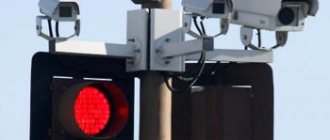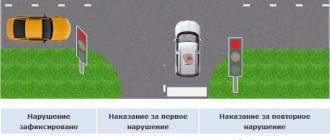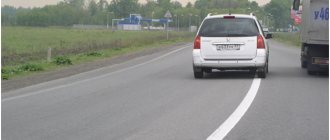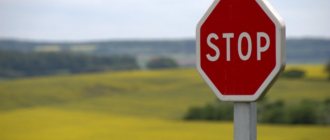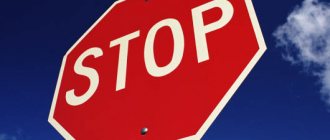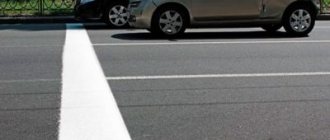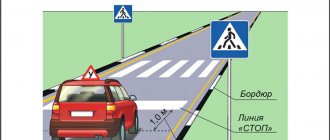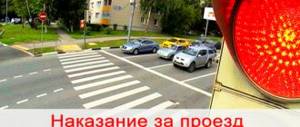Many drivers are interested in the algorithm for triggering automatic cameras at intersections. The driver is not able to thoroughly determine the distance from the wheels to the stop line. Punishment decisions often come to those who are sure that they have not committed an offense. Some are trying to appeal the fine. But judges, as a rule, are not on the side of drivers. Therefore, it is important to find out how the process of recording a collision with a stop line occurs when the camera detects the intersection of the markings.
What violations are recorded by traffic police cameras?
Rules for driving through a stop line and stopping in front of it
From the very beginning after obtaining your driver's license, it is important to understand the restrictions of road markings. The stop line deserves special attention. The rules for crossing it are reflected in Part 2, Section 2.5 of the Russian Traffic Regulations.
In this case, the stop line can be applied either directly to the road surface or installed in the form of a red octagon, in the center of which the Latin letters STOP are located. Often such signs are installed in front of unregulated intersections, pedestrian crossings, traffic lights, and railway crossings.
In the latter case, such markings on the asphalt are often missing for various reasons. Under these circumstances, you need to stop the car so that its hood does not cross the traffic light. At an unregulated intersection, it is important to stop in front of the stop line, as this gives you the opportunity to look around, assess the specific road situation, and make sure it is safe to travel. It should be remembered that this marking on the road does not always determine the boundary of the intersection.
It is strictly forbidden to park your car in front of the stop line, since such actions cannot be carried out closer than 5 meters before the crossing or intersection of roads.
In addition, this line is a priority feature over railway crossings. This is due to the need to ensure efficient operation of the barrier.
See also:
Do I need to pay a fine if it arrives without a photograph?
Who has the right to fine
An employee of the State Traffic Inspectorate in the performance of his official duties has the right to impose an administrative penalty for driving at a stop line. Failure to comply with legal requirements recorded using photo and video cameras installed by the traffic police is also considered legal.
Driving beyond the stop line is often recorded by cameras, so do not neglect traffic rules
Collision camera recognition mechanism
The reference points for the operation of video surveillance systems are special photo marks, which are entered into the program during calibration. When installing the camera, the camera lens is adjusted to provide the best visibility while taking into account possible body interference. To avoid distortion, sensitivity to highlights and shadows is adjusted. In addition, infrared emitters increase the camera's performance at night.
To better designate the stop line, an additional sign 6.16 is used, which duplicates it. This helps you find your way even in cases where the markings are hidden under snow or ice. In such situations, you need to stop the car in front of the line at the level of the sign.
It is important to take into account that even in the absence of a drawn line on the asphalt, the device, with the help of tags, will be able to determine the boundary that cannot be crossed by driving over it with the wheels of a car. At the same time, you can cover it with a bumper without breaking the law. A properly adjusted camera has a small error, so false fixations are almost impossible.
See also:
What fines will drivers be exempt from in 2021?
How to drive through an intersection according to the rules
The stop line cannot be drawn directly at the intersection of the boundaries of the intersection, which is considered the beginning of the curve of the road
It is important to understand that you need to react to this type of marking if a traffic light signal has been given to stop
When to stop before markings
Marking 1.12 (sign 6.16) is crossed without stopping when the light is green. The car can drive further without slowing down.
The transverse line drawn on the road is the place in front of which the car must stop if the traffic light is red. The driver must stop the car if the traffic controller made a gesture prohibiting further movement.
Be sure to stop if:
- There is a stop line on the road and the traffic light is red.
- A traffic police officer (traffic controller) gives a sign to stop.
You can be fined not only for stopping a car behind the line, but also for starting to drive at a yellow traffic light. This action is equivalent to crossing the markings.
If crossed the line
The driver may become distracted and accidentally stop further than the stop strip. What to do next to avoid a fine. You can only reverse if there are no obstacles or obstacles. This is not the best way out of the situation; photographic recording of crossing markings at a traffic light will work.
In the current situation, you should stay where you are. You can move if the traffic controller notices a motorist who has accidentally driven further than expected and gives the signal to remove the car and drive forward.
If you can't stop
When the driver realizes that due to an unexpected malfunction he cannot stop the car, he needs to turn on the emergency signal. The situation is rare and critical. There are no other valid reasons to slow down and park the car in the specified place.
Driving outside the line in case of a traffic jam
Typically, offenses at intersections are recorded by cameras equipped with motion sensors. The devices in traffic lights are configured so that they only react to cars that move after the red light turns on.
Situations and penalties
When driving a car under various conditions, the driver must first of all focus on the instructions of road signs and markings.
Any traffic violations can be recorded using CCTV cameras. Their installation is indicated by a special sign 8.23, which depicts a camera.
Violations of road markings and stops at pedestrian crossings are recorded using technical means. The rules for stopping in front of the stop line may vary in different specific situations.
Violations of the rules for crossing the mandatory stop line, which are recorded by a video surveillance camera, provide for the following fines:
- when crossing railway tracks with a functioning traffic light or sound signal in accordance with clause 12.16.1 of the Code of Administrative Offenses of the Russian Federation, a penalty of 1000 rubles is imposed, and the driver’s license is taken away for 6 months;
- at an unregulated intersection - 500 rubles (12.16.1 Code of Administrative Offenses of the Russian Federation);
- at a controlled intersection - 800 rubles (12.12.2 Code of Administrative Offenses of the Russian Federation).
It should be remembered that a repeated violation entails deprivation of the right to drive a car for a period of 12 months. If you pay the fine 20 days after the ruling is issued, you can save 50% of the money.
See also:
Drivers will be deprived of their licenses for dirty license plates
???? Recording vehicle movement through parking spaces
Recently in Moscow, video recording was installed to control traffic through parking lots. This measure will help eliminate situations in which drivers create interference and obstacles to the main flow.
Such drivers avoid traffic jams in empty parking pockets, and then try to wedge into a row. However, they forget that by crossing the horizontal markings (line 1.1 according to traffic rules), indicating the boundaries of parking zones, they commit an offense under Part 1 of Art. 12.16 of the Code of Administrative Offenses and receive a fine of 500 rubles.
So far, such a video recording complex has been installed at one address - st. Kosygina 7. But, most likely, their number will grow steadily. After all, the use of such systems can significantly reduce the number of traffic violations.
Today, cameras can recognize about 16 different types of violations. Some of them will be discussed below.
Is it possible to challenge
Usually, a photograph is attached to the envelope along with the fine as proof of the violation. It is better to study it carefully, as this may be grounds for challenging this sanction.
It is possible to challenge a fine under the following circumstances:
- traffic violations have not been accurately recorded, vehicle registration plates cannot be accurately identified;
- the photo shows a different car, with a different driver behind the wheel;
- only the bumper is behind the mandatory stop line, and the wheels have not driven over the markings;
- The car crossed the stop line at a green traffic light.
If the petition does not bring the desired result, then you can continue to fight for your interests in court. To file a claim, it is important to use the testimony of witnesses, a video recorder, and other documents.
See also:
What is more profitable - to challenge the traffic police fine or to pay?
Thus, the development of digital technologies makes it easier to control the situation on the road. On the other hand, even the use of modern devices does not protect drivers from unlawful punishment. It is important to scrupulously follow traffic rules and, if necessary, defend your rights.
???? What fines are recorded by photo and video cameras in 2021
Speed violation
All video recording kits undergo the necessary tests and certification - video cameras clearly monitor the speed of movement. That is why it is difficult to appeal fines issued from video cameras.
Article 12.9 of the Code of Administrative Offenses establishes:
- fine 500 rub. for speeding by 20–40 km/h;
- 1500 rub. — for exceeding 40–60 km/h;
- 2500 rub. — for exceeding 60–80 km/h;
- the most severe punishment is 5,000 rubles. - for speeding by more than 80 km/h.
Driving through a prohibitory traffic light
- Recording this violation with a video camera results in a fine of 1,000 rubles. (Part 1 Article 12.12).
- Repeated - up to 5000 rubles. (Part 3 of Article 12.12).
By the way, many people mistakenly believe that it is possible to move on a yellow signal. But clause 6.2 of the traffic rules clearly states that the yellow signal (with the exception of some cases) is a signal prohibiting movement. Therefore, video cameras are set to record the passage of a car at both red and yellow lights.
Who belongs to senior medical personnel View
Legislatively established standards for air temperature in an apartment during the heating season View
Driving on the side of the road
According to traffic rules, the shoulder is a section of the road next to it. Pedestrians and cyclists move along it. Motorists may only pull onto the side of the road to stop.
That is why avoiding traffic jams on the side of the road is a violation. Video recording leads to a fine of 1,500 rubles (Part 1 of Article 12.15).
Violation of markings (crossing a solid line)
The driver must constantly ensure that his car does not cross solid lines, since crossing any of them (not counting parking lines) is a violation.
Registration with a video camera leads to various fines. In this case, the trajectory of the car is recorded in a photograph attached to the resolution.
The largest fine is 5,000 rubles. — established for overtaking (part 4 of article 12.15). In other cases, a fine of 500 (Part 1 of Article 12.16) or 1,500 rubles may be imposed. (Part 3 of Article 12.15 or Part 2 of Article 12.16).
Entering a dedicated lane
Dedicated lanes for public transport have appeared relatively recently. Moscow was the initiator of this. Then the regions took up this initiative.
If an ordinary motorist decides to take a quick ride along a dedicated free lane, then he must understand that he is violating clause 18.2 of the traffic rules. In the regions, he will pay 1,500 rubles (Part 1.1, Article 12.17). And in Moscow and St. Petersburg - 3,000 rubles (Part 1.2, Article 12.17).
Entering a busy intersection
During rush hours, traffic at intersections in large cities is very heavy. And there will always be daredevils who will drive into an intersection, knowing that getting out of it will be problematic. At the intersection they will be forced to stop, thereby blocking traffic perpendicular to flows.
Now, in order to avoid this, the concept of “waffle” markings at intersections has been established - it is forbidden to enter an area with these markings if traffic there is difficult. Punishment - 1000 rubles. (Part 1 Article 12.13).
When entering an intersection with “waffle” markings, the camera will register a violation at the moment the traffic light turns on and the car is inside this marking.
The law established the amount of hostel fees Read
Don't subscribe to too much! What is considered an imposition of services and how to get your money back Read
Crossing the stop line
Recording of this violation using cameras in Moscow began in 2021. When driving through intersections without installed stop line signs, you should remember that video cameras record a violation when driving onto the stop line with two wheels.
The assigned punishment is 800 rubles. (Part 2 of Article 12.12). If there is a sign in front of the stop line, then the punishment will be milder - 500 rubles. (Part 1 of Article 12.16 of the Administrative Code).
Stopping in a prohibited place
Modern photo-video recording systems can recognize cars stopped in traffic even for 10 seconds.
The penalty for stopping in the wrong place is from 1000 to 2000 rubles. (v. 12.19). If this violation was committed in Moscow or St. Petersburg, the fine will be 3,000 rubles. (Part 6, Article 12.19).
Making a turn from the second row
Video cameras also record cases of turning and leaving roads not from your lane (for example, from the second and even third row).
In the case of installed road signs or if there are markings that require following the appropriate lanes, when turning left, a motorist will be fined 1,500 rubles. (Article 12.16 part 2). When turning right - by 500 rubles. (Article 12.16 part 1). At the same time, the camera also records the trajectory of the car in the photograph attached to the resolution.
